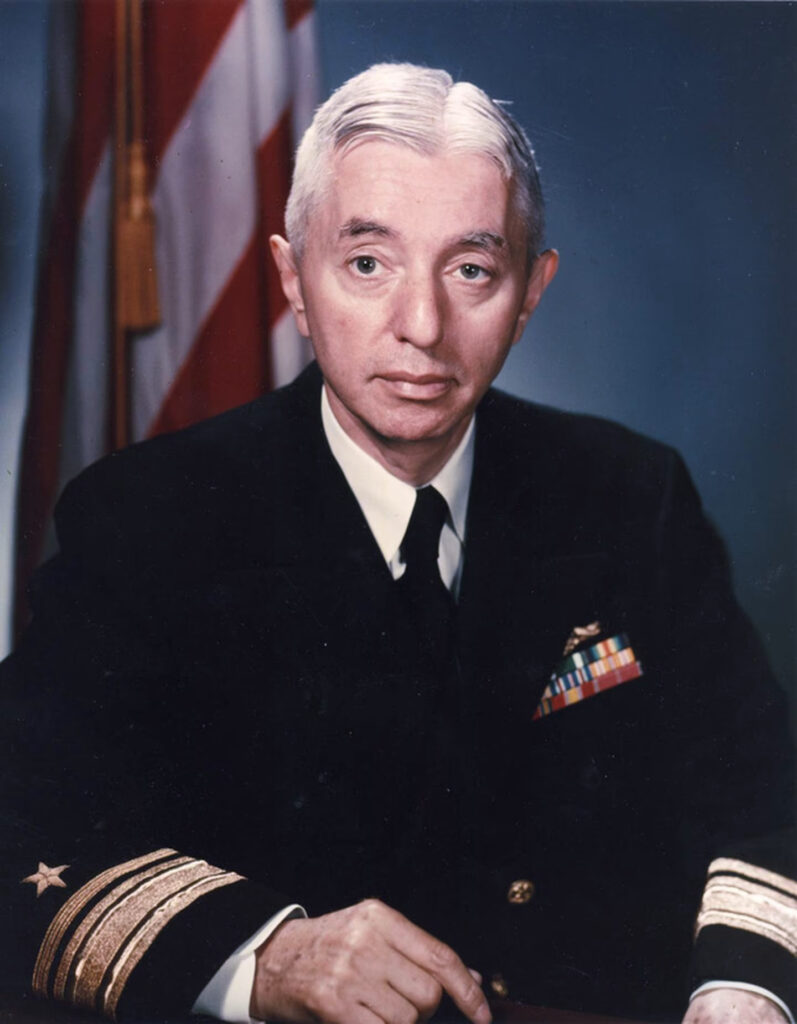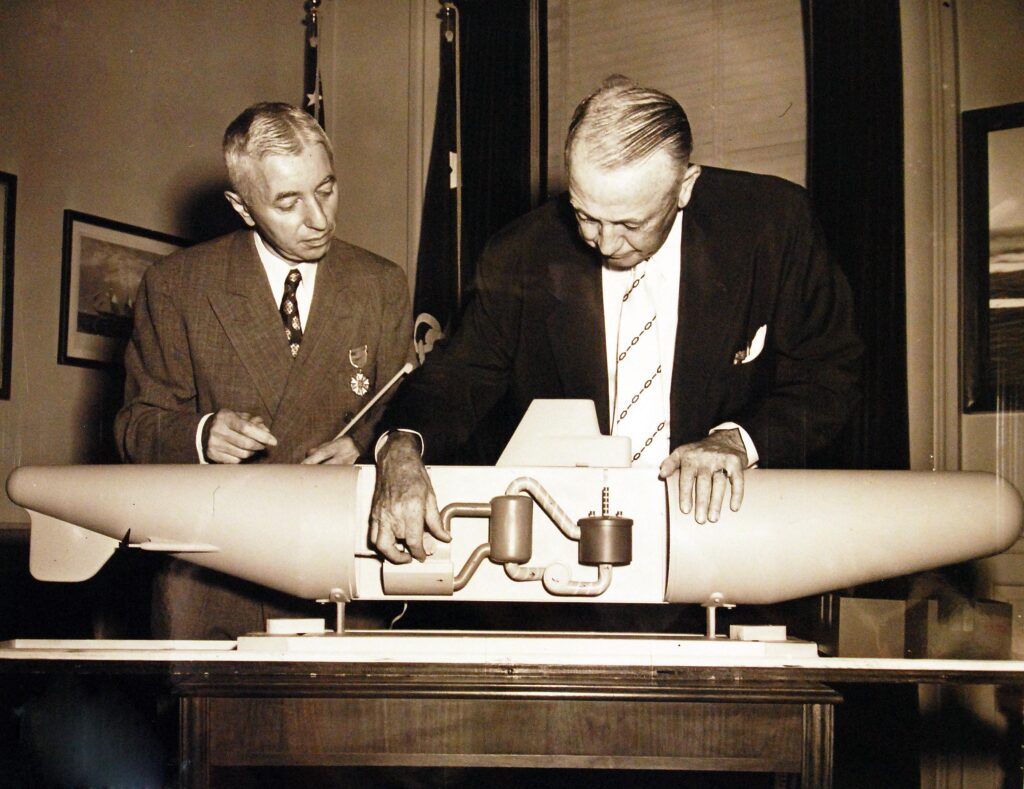By Mitchell Trantow, Intern, University of MN-Duluth
Author’s Note: I have served in the United States Navy (2017-2023) as an enlisted nuclear technician on an aircraft carrier. Although I intend to only tell the history of this man, I have a bias in favor of the Admiral that must be addressed before further reading.

Hyman Rickover
Rickover was born on January 27, 1900 in Poland. The son of a Jewish tailor, his family emigrated to the United States in order to avoid the Russian pogroms in 1905. Rickover obtained a position at the Naval Academy at Annapolis in 1918, where he performed well as a bookish and fervently studious individual. After graduating in 1922, he served in the peacetime Navy before heading the electrical division of the Bureau of Ships during the Second World War. After the war he designed the USS Nautilus (SSN-571), launching the United States Navy into the nuclear age of propulsion and greatly improving the capabilities of submarines. He continued to serve as head of the Navy’s Nuclear program and held the shipbuilding contractors as well as his officers to an incredibly and demandingly high standard. He was forced to retire in 1982 by President Reagan due to his age and allegations of receiving bribes. Recipient of two Congressional Gold Medals, the Presidential Medal of Freedom, Rickover’s Naval career spanned 63 years making him the longest serving member of the United States armed forces to date. He passed on July 8, 1986 and was buried in Arlington National Cemetery.
Early Life
Born Chaim Gdala/Godalia/Godeliah Rykower in Makow, Russian-occupied Poland, to a Jewish family. His family fled the Russian pogroms in 1905 to the United States where they would ultimately settle in Chicago, Illinois. His first name was changed to “Hyman” derived from the Jewish word “Chayyim” (meaning “life”). During his childhood, he worked alongside his siblings to help his family make ends meet through various odd jobs (including delivering messages for Western Union). His middle name was changed to George when he entered the Naval Academy, where he endured both the traditional hazing, which by his own testimony he was mature enough to handle, as well as additional mistreatment due to his Jewish heritage. His family life was strict, demanding, and not always affectionate, but it was fair and loyal in a way which shaped Rickover’s character.
Military Career
Obtaining a commission to the Naval Academy at Annapolis in 1918, Rickover shunned social events and parties in favor of studying and education. He disliked those who insulted him for his Jewish heritage but did not detest the more traditional treatment and hazing which most endured. He graduated 107th out of 540 midshipmen in 1922, and received his officer’s commission as well as orders to the USS La Vallette (DD-315) as the Assistant Torpedo Officer, commissary, supply, and watch officer. He endured a series of medical ailments which hindered him throughout his service on the La Vallette and later on the battleship USS Nevada (BB-6). He attended Columbia University where he obtained his Master’s in Science in Electrical Engineering and met Ruth Masters 1927-29. He reported for service on the submarine S-9 (SS-114) and later S-48 (SS-159) where he became the engineering and electrical officer. He married Ruth Masters in 1931 after reporting for duty to the S-48. During his time aboard these submarines he found certain pieces of equipment to be deficient and developed various improvements and improvisations to fix these issues with the submarines he served on. After a brief stint in command of the minesweeper USS Finch (AM-9), he was ordered to head the Electrical Section of the Bureau of Ship from 1939-45. There he worked to help design, improve, and oversee the shipbuilding process of warships for the war effort. By 1945 he served as commander of Naval Repair Base, Okinawa to the close of the Second World War. He spent some time in occupied Japan through 1945, and worked as part of a Navy outreach program by assisting education programs in Japanese regions ravaged by the war and typhoons.
The end of the Second World War led to Truman ordering the formation of the Atomic Energy Commission (AEC) in 1946. Then-Captain Rickover and other naval officers alongside civilians reported to Oak Ridge, Tennessee to develop ship propulsion capabilities with nuclear power. Realizing the potential of nuclear power for submarine propulsion, Rickover, the other officers, and civilians began designing a feasible reactor for this purpose. With the onset of the Cold War and focus on atomic power as solely for weapon production, Rickover had to badger, cajole and bully his way into Truman’s office to convince him of the necessity of nuclear propulsion for the Navy. With Truman’s blessing, Rickover went ahead and developed the first nuclear reactor for submarine propulsion while also advocating for commercial use of reactors for civilian power production. The USS Nautilus (SSN-571) was launched in 1955, the first submarine that could remain submerged as long as its food supply lasted. Rickover did not remain idle, and wasted no time building up the U.S. Navy’s fleet of nuclear submarines.
He continued to develop and improve designs for the growing fleet of submarines, he also began to personally screen every engineering and command officer for the submarine fleet. One such officer was James Carter, the 39th President of the United States, who would award Rickover the Presidential Medal of Freedom for his service to the country. He oversaw all aspects of the construction of submarines and held contractors to a high standard, frequently refusing to pay them if he felt they had produced a substandard ship. During John Kennedy’s administration, he advised the President against forming a submarine multilateral force (MLF); an American foreign policy proposal to have internationally manned crews of NATO nuclear missile submarines (SSBNs) on account of difficulty with communication and operational security management. President Kennedy was convinced by this argument and forbade the proposed MLF for submarines. Approaching his retirement deadline, Secretary of the Navy Korth announced that Vice Admiral Rickover would be recalled to service if deemed necessary, subject to re-appointment every two years. This became a workaround to keep Rickover in his position, maintaining the nuclear navy.

Rickover inspects model of USS Nautilus with Secretary of the Navy Dan A. Kimball
After the death of his mother and wife as well as suffering from a heart attack, Rickover was promoted to a full Admiral on December 3, 1973. He was remarried in 1974 to Eleonore Bednowicz. During Carter’s presidency he developed the Los Angeles class submarine. As he grew older, increasing calls for his resignation alongside claims of bribery from General Dynamics prompted the Reagan administration to force Rickover to retire in 1982. By his own testimony he found out through his wife hearing about it on the national news, rather than being informed personally. Rickover did not deny receiving around $67,000 worth of “gifts” from General Dynamics, General Electric, and Newport News Shipyard but he disputed whether it influenced him in favoring them. Despite the bribes, Rickover denied around $800 million in construction claims by General Dynamics; about $643 million of these were later awarded to General Dynamics. A strong advocate of nuclear power for civilian as well as military use, he deplored the development of atomic weapons and testified before Congress on matters concerning the threat of nuclear annihilation. Asked about the likelihood of nuclear war:
“Well I think we’ll probably destroy ourselves. So what difference will it make? Some new species will come up that might be wiser than we are. I do not believe in divine intercession. In the eyes of the Lord, we are not the most important thing in the universe.”
“The Kindly Old Gentleman”
Rickover was known for his personal interviews of every nuclear engineering officer for the Navy, a practice continued to this day by the acting Admiral of Naval Reactors. Every applicant would be screened through an oral board process where they would answer technical problems in mechanical/electrical engineering, chemistry and physics before interviewing with Rickover himself. Upon obtaining the interview they would sit in a polished smooth chair with the front two legs being sawed 6 inches shorter, meaning the interviewee would have to balance themselves while being asked technically challenging questions. If they gave the Admiral “stupid answers,” he would lock them in a broom closet until they could give him a proper answer. Alongside his regular inspections of the nuclear vessels, these interviews earned him the derisive moniker of “The Kindly Old Gentleman,” or “KOG” for short. One famous individual who passed this interview process was James Carter, the 39th President of the United States.
Death and Legacy
Rickover died on July 8, 1986 and is buried in Arlington National Cemetery. He was widely regarded as one of the most technically experienced men the Navy ever had. He is also remembered as a blunt and provocative admiral who refused to compromise on how he operated, making him few friends and many enemies in the Navy and military contractors. Throughout his lifetime he was a strong advocate for education reform as early as the 1950s, where he argued that the American education system was failing the current and future generations and should be more affordable to promising students. His moniker as the Kindly Old Gentleman derisively characterised his own style of leadership through demanding more from his subordinates than they believed possible. Two submarines have been christened in his honor; one Los Angeles submarine in 1984 (SSN-709) and the newer Virginia class in 2023 (SSN-795). Regardless of his individual personality and scandal in the shipyard industry, he prepared the United States Navy for the nuclear age to the best of his ability.
Sources
– US Naval Heritage and History Command Archives
– CBS “60 Minutes” interview with Diane Sawyer, 6/23/1985
– https://time.com/archive/6621673/science-the-man-in-tempo-3/
– https://www.usna.edu/Library/sca/man-findingaids/view.php?f=MS_561
– https://www.defensemedianetwork.com/stories/underway-on-nuclear-power-a-new-change-in-naval-history/
Photos from Wikimedia Commons; official U.S. Navy photos